Unit 6 How do you feel Part B Let’s talk 教案(含反思,详案与简案)
文档属性
| 名称 | Unit 6 How do you feel Part B Let’s talk 教案(含反思,详案与简案) |  | |
| 格式 | zip | ||
| 文件大小 | 115.4KB | ||
| 资源类型 | 教案 | ||
| 版本资源 | 人教版(PEP) | ||
| 科目 | 英语 | ||
| 更新时间 | 2020-07-25 15:18:03 | ||
图片预览




文档简介
Unit
6
How
do
you
feel
The
third
period(第三课时)
Part
B
Let’s
try
&
Let’s
talk
?教学内容与目标
课时教学内容
课时教学目标
Let’s
try
·能够读懂题目要求,能够在听前预测听力重点内容·能够运用基本听力技巧完成Let’s
try板块的听力任务·能够对即将发生的故事进行预测·能够运用基本听力技巧完成与细节相关的听力练习
Let’s
talk
·通过观察、谈论Let’s
talk板块的图片,在图片、PPT和老师的帮助下理解对话大意,并回答对话后面的问题·通过听录音,学会用正确的意群及语音、语调朗读对话,并能在小组中进行角色表演·能够在情景中运用句型“…should…”和“Don’t…”提出建议·能够使用“What’s
wrong?”询问他人状况·能够在语境中借助图片等帮助理解“wrong,
should,
feel,
well”的意思,并能正确发音·在教学过程中,对学生进行不能以自我为中心,要关心他人,为他人着想的德育教育
?教学重点
能够理解对话大意,并能用正确的意群及语音、语调朗读对话。
?教学难点
能够在情景中运用句型“…should…”和“Don’t…”提出建议。
?教学准备
PPT课件?课文录音?视频、时钟教具等。
?教学过程
Step
1:
Warm-up
&
Revision
&
Lead-in
1.
Greetings.
2.
Revision.
Show
some
pictures
on
the
PPT.(课件出示:表示不同情绪或状态的图片,如angry,
afraid,
ill,
sad,
worried,
happy等)
Talk
about
them
with
students.
Help
students
review
the
words
of
feelings.
T:
How
does
he/
she
feel?
Ss:
He’s/
She’s…
…
T:
…is
ill.
What
will
you
say
to
him/
her?
Lead
students
to
answer
by
using
“He/
She
should…”
Ss:
He/
She
should
go
to
the
hospital.
T:
Yes.
He/
She
should
see
a
doctor.
3.
Lead-in.
T:
That’s
a
good
suggestion.
Today
we
are
going
to
learn
how
to
give
suggestions.
Write
down
the
topic
“How
do
you
feel?”
on
the
blackboard.
Step
2:
Presentation
1.
Finish
the
exercises.
(1)
Predict
the
listening
content.
Show
the
part
of
“Let’s
try”
to
students.
(课件出示:教材P60
Let’s
try板块的内容)
T:
It’s
seven
o’clock
in
the
morning,
and
it’s
time
to
get
up.
Two
people
are
talking.
Who
are
they?
Doctors
or
parents?
Can
you
guess?
Show
the
words
“doctors,
parents”
to
students.(课件出示:doctors和parents两个单词)
(2)
Read
the
questions.
T:
Who
is
talking?
What
are
they
talking
about?
Let’s
listen
and
circle.
Please
pay
attention
to
the
options.
We
should
listen
and
circle
the
right
answers.
Students
read
the
questions
quickly
by
themselves.
(3)
Play
the
recording.(课件出示:教材P60
Let’s
try板块的音频)
Students
listen
to
the
recording
and
try
to
circle
the
right
answers.
(4)
Play
the
recording
again
and
check
the
answers.
(5)
Talk
about
the
listening
material.
Questions:
①Who
is
talking?
(Parents.)/
②What
are
they
talking
about?
(Going
to
the
zoo.)/
③What’s
wrong
with
Dad?(He’s
ill./He
has
a
fever.)/
④What
should
he
do?(He
should
see
a
doctor.)
2.
Look
and
predict.
Show
the
picture
to
students.
(课件出示:教材P60
Let’s
talk板块的图片)
Let
students
look
at
the
picture
carefully.
Ask
some
questions
to
lead
them
to
predict
the
main
idea
of
the
dialogue.
Questions:
①Who
are
they?/②What
are
they
talking
about?/③How
does
Sam
feel?/…
3.
Watch
and
answer.
Show
the
questions
on
the
PPT.
(课件出示:下列问题)
Let
students
watch
the
cartoon
and
try
to
answer
the
questions.
Q1:
What’s
wrong?
Q2:
How
does
Sam
feel?
Q3:
What
does
Sam’s
mum
say?
Play
the
cartoon.(课件出示:教材P60
Let’s
talk板块的视频)
Students
watch
the
cartoon.
Then
check
the
answers.
A1:
Sam’s
father
is
ill.
A2:
He
is
sad.
A3:
Don’t
be
sad.
Write
down
the
sentences
“What’s
wrong?”
“Don’t
be
sad.”
on
the
blackboard.
And
then
teach
them.
Lead
students
spell
the
word
“wrong”
by
themselves.
T:
The
letter
“w”
doesn’t
sound
in
this
word.
Students
practice
the
word
and
the
sentences.
4.
Read
and
answer.
Learn
the
new
words
and
sentence.
Show
the
questions
on
the
PPT.(课件出示:下列问题)
Q4:
Sam’s
father
is
ill.
What
should
he
do?
Q5:
Sam
is
sad.
What
should
he
do?
Students
read
the
dialogue
and
try
to
answer
the
questions.
A4:
He
should
see
a
doctor.
A5:
He
should
go
to
the
zoo
next
time.
Write
down
the
sentence
“He
should
see
a
doctor.”
on
the
blackboard.
Then
teach
the
word
“should”
and
the
sentence.
Ask
students
to
practice
in
pairs.
T:
What
does
Sam
say?
Ss:
He
says,
“How
does
Dad
feel
now?”
Lead
students
to
answer
the
question.
T:
Yes.
His
father
is
not
well.
Sam
cares
for
his
father.
He
should
go
to
the
hospital
with
his
father.
We
should
care
for
others.
Help
students
understand
the
words
“feel,
well”.
Help
students
establish
the
consciousness
of
caring
for
others.
5.
Read
and
act.
(1)
Let
students
read
after
the
recording.(课件出示:教材P60
Let’s
talk板块的音频)Let
them
pay
attention
to
the
pronunciation
and
the
intonation.
(2)
Let
students
practice
the
dialogue
in
groups.
(3)
Let
students
act
out
the
dialogue.
Step
3:
Practice
1.
Look
and
say.
Show
the
pictures
on
the
PPT
one
by
one.(课件出示:逐一出示爬树图、生病图、让座图和禁止游泳图)
Students
look
and
try
to
say.
2.
Pair
work.
(1)
Show
the
pictures
in
the
book
to
students.(课件出示:教材P60
Let’s
talk板块的Act
with
your
friends的图片)
T:
Your
friends
need
some
help.
Call
them
and
give
them
your
suggestions.
(2)
Make
a
demonstration.
Look
at
the
first
picture.
Make
a
demonstration
with
a
student.
Simulate
a
phone
call
with
your
hands.
T:
What’s
wrong
with
you?
S1:
I’m
angry.
T:
Don’t
be
angry.
You
should
take
a
deep
breath.
(3)
Practice
in
pairs.
(4)
Show
time.
S1:
What’s
wrong
with
you?
S2:
I’m
ill.
S1:
Oh.
I’m
sorry
to
hear
that.
You
should
see
a
doctor.
S3:
What’s
wrong
with
you?
S4:
I’m
sad.
S3:
You
should
listen
to
happy
music.
T:
You
should
think
about
some
happy
things/read
a
joke
book.
Ask
several
students
to
show
to
the
class.
The
other
students
listen
to
them
and
make
evaluations.
Step
4:
Consolidation
&
Extension
“Play
a
psychologist”
1.
Create
a
situation.
Show
a
picture
of
a
psychologist
on
the
PPT.
(课件出示:一张心理医生照片)
T:
There’s
a
special
job—the
psychologist.
He/
She
helps
other
people
in
psychology.
He/
She
can
give
some
suggestions
to
people.
Show
some
words
of
the
feelings
on
the
left
of
the
PPT.(课件左侧出示:一些表示各种情绪或感觉的词汇,如angry,
afraid,
ill,
sad,
worried,
happy,
hungry,
tired等)Students
read
the
words
one
by
one.
Show
some
words
or
phrases
of
some
actions
on
the
right
of
the
PPT.(课件右侧出示:一些动词或动词词组,如dance,
swim,
listen
to
music,
sing
songs,
draw
cartoons,
read
books,
watch
TV,
do
exercise,
go
shopping,
play
basketball,
play
sports等)
Students
read
the
words
or
the
phrases
one
by
one.
2.
Make
a
demonstration.[来源:学科网ZXXK]
T:
I’m
a
psychologist
now.
What’s
wrong
with
you?
How
do
you
feel?
S1:
I
am
angry.
T:
Don’t
be
angry.
You
should
take
a
deep
breath.
Can
you
tell
me
something?
…
3.
Work
in
groups.
T:
Now
please
work
in
groups
of
four.
4.
Show
time.
Ask
several
students
to
show
to
the
class.
The
other
students
listen
to
them
and
make
evaluations.
?板书设计
?教学反思
1.教学活动设计具有梯度性,遵循学生的认知规律,以学生为本,以问题为导向,引导学生学习,培养学生的自主学习能力。
2.在听力教学中,逐步帮助学生读懂题目要求,引导学生学会听前预测听力的重点内容。
3.在情境中理解,在活动中运用,突出语用功能。通过创设合理情景,帮助学生在情景中真实自然地使用所学语言,突出教学重点。
4.在教学过程中,对学生进行不能以自我为中心,要关心他人,为他人着想的德育教育。
?Teaching
Contents
&
Teaching
Aims
Let’s
try
?·
Be
able
to
understand
the
requirements
of
the
questions
and
predict
the
main
content
of
the
listening
part.
?·Be
able
to
use
basic
listening
skills
to
complete
the
listening
tasks.
?·Be
able
to
predict
what
will
happen.
?
·Be
able
to
use
basic
listening
skills
to
complete
the
detailed
listening
exercises.
Let’s
talk
·Be
able
to
understand
the
main
idea
of
the
dialogue
by
observing
and
talking
about
the
pictures,
be
able
to
answer
the
questions
below
the
dialogue.
·Be
able
to
read
the
dialogue
correctly,
fluently
and
emotionally
and
act
it
out
in
groups.
·
Be
able
to
use
the
sentence
structures
“…should…”and
“Don’t…”to
give
suggestions
properly
in
situations.
·Be
able
to
ask
other
people
by
using“What’s
wrong?”
·
Be
able
to
understand
and
read
the
new
words
“wrong,
should,
feel,
well”
correctly
in
situations.
·Help
students
establish
the
consciousness
of
caring
for
others.
?Teaching
Priorities
·Be
able
to
understand
and
read
the
dialogue
correctly,
fluently
and
emotionally.
?Teaching
Difficulties
·Be
able
to
use
the
sentence
structures
“…should…”
and
“Don’t…”
to
give
suggestions
properly
in
situations.
?Teaching
Procedures
Teaching
Stages
Teacher’
s
Activities
Students
Activities
Teaching
Purposes
Warm-up&Revision&Lead-in
1.
Greetings.
2.
Revision.
Show
some
pictures
on
the
PPT.
Talk
about
them
with
students.
Help
students
review
the
words
of
feelings.Lead
students
to
answer
by
using
“He/
She
should…”3.
Lead-in.
1.
Greetings.2.
Look
at
the
pictures
and
talk
about
them
with
the
teacher.
Review
the
words
of
feelings.
Try
to
answer
by
using
“He/She
should…”
Stimulate
students’
interest
in
learning
and
help
them
review
some
words.
Lead
in
the
topic
of
giving
suggestions.
Prepare
for
the
further
learning
and
permeate
the
sentence
structure
in
advance.
(续表)
Teaching
Stages
Teacher’
s
Activities
Students’
Activities
Teaching
Purposes
Presentation
1.
Finish
the
exercises.(1)
Let
students
predict
the
listening
content.
Show
the
part
of
“Let’s
try”.Show
the
words
“doctors,
parents”.[来源:学科网]Lead
students
to
predict.(2)Let
students
read
the
questions
quickly
by
themselves.(3)Play
the
recording.(4)Play
the
recording
again
and
check
the
answers.(5)Talk
about
the
listening
material.
(1)
Look
at
the
part
of
“Let’s
try”
and
the
two
words,
and
predict
the
listening
content.[来源:学+科+网](2)
Read
the
questions
quickly.(3)
Listen
to
the
recording
and
try
to
circle
the
right
answers.[来源:学科网ZXXK](4)
Check
the
answers.(5)
Talk
about
the
listening
material.
Lead
students
to
predict
the
listening
content
before
listening.
Cultivate
students’
logical
reasoning
ability.[来源:学科网ZXXK]
2.
Look
and
predict.Show
the
picture
to
students.Let
students
look
at
the
picture
carefully.Ask
some
questions
to
lead
them
to
predict
the
main
idea
of
the
dialogue.
Look
at
the
picture
carefully.
Answer
the
questions.Predict
the
main
idea
of
the
dialogue.
Use
the
questions
and
the
picture
to
help
students
predict
the
main
idea
of
the
dialogue.Activate
the
old
knowledge.
3.
Watch
and
answer.Show
the
questions
on
the
PPT.
Play
the
cartoon
and
check
the
answers.Teach
the
sentences
“What’s
wrong?”
“Don’t
be
sad.”Let
students
spell
the
word“wrong”
by
themselves.
Watch
the
cartoon
and
try
to
answer
the
questions.Check
the
answers.Learn
and
practice
the
word
and
the
sentences.
Use
the
questions
to
lead
students
to
understand
the
dialogue
step
by
step.Help
students
understand
the
new
word
and
sentences.
4.
Read
and
answer.
Learn
the
new
words
and
sentence.Show
the
questions
on
the
PPT.
Let
students
read
the
dialogue
and
try
to
answer
the
questions.Teach
the
word
“should”
and
the
sentence
“He
should
see
a
doctor.”Help
students
understand
the
words
“feel,
well”
and
establish
the
consciousness
of
caring
for
others.
Read
the
dialogue
and
try
to
answer
the
questions.
Learn
the
word
“should”
and
the
sentence.Practice
the
word
and
the
sentence
structure
in
pairs.Learn
the
words
“feel,
well”
and
try
to
understand
them.Establish
the
consciousness
of
caring
for
others
with
the
help
of
the
teacher.
Use
the
questions
to
lead
students
to
learn
the
new
words
and
the
sentence
structure.Help
students
establish
the
consciousness
of
caring
for
others.
5.
Read
and
act.(1)
Let
students
read
after
the
recording.
(2)
Let
students
practice
the
dialogue
in
groups.(3)
Let
students
act
out
the
dialogue.
(1)
Read
after
the
recording.
(2)
Practice
the
dialogue
in
groups.(3)Act
out
the
dialogue.
Make
sure
students
can
read
the
dialogue
correctly
and
fluently.
Practice
1.
Look
and
say.Show
some
pictures
on
the
PPT
one
by
one.
2.
Pair
work.(1)
Show
the
pictures
in
the
book
to
students.(2)
Make
a
demonstration.Make
a
demonstration
with
a
student.
Simulate
a
phone
call
with
the
hands.(3)
Practice
in
pairs.(4)
Show
time.
1.
Look
at
the
pictures
and
try
to
say.2.
(1)
Observe
the
pictures
in
the
book.(2)
A
student
makes
a
demonstration
with
the
teacher.(3)
Practice
in
pairs.(4)
Several
students
show
to
the
class.
The
other
students
listen
and
make
evaluations.
Help
students
practice
the
key
words
and
sentence
structures
through
scenes
made
of
pictures
and
give
them
some
suggestions.
Consolidation&Extension
“Play
a
psychologist”1.
Create
a
situation.
Show
a
picture
of
a
psychologist
on
the
PPT
and
introduce
the
job.Show
some
words
of
feelings
on
the
left
of
the
PPT.
Show
some
words
or
phrases
of
some
actions
on
the
right
of
the
PPT.
2.
Make
a
demonstration.3.
Work
in
groups.4.
Show
time.
1.
Learn
about
the
psychologist.Read
the
words
or
the
phrases
one
by
one.2.
A
student
makes
a
demonstration
with
the
teacher.3.
Work
in
groups
of
four.4.
Several
students
show
to
the
class.
The
other
students
listen
to
them
and
make
evaluations.
Create
a
real
situation
to
develop
students’
comprehensive
language
using
ability.Help
students
learn
about
the
psychologist
and
try
to
give
others
some
appropriate
suggestions.
Homework
1.
Practice
the
dialogue.2.
Do
the
exercises.
Teaching
purpose
利用不同情绪或状态的图片,帮助学生复习相关的单词,唤醒旧知,激发学生的学习兴趣,为后面的学习做好铺垫,并提前渗透句型。
Teaching
purpose
逐步帮助学生读懂题目要求,引导学生学会听前预测听力的重点内容。再次听录音核对答案,就录音内容与学生进行对话练习。
Teaching
purpose
通过预测教学内容激活已有知识,并提取与文本有关的知识,进入文本话题。
Teaching
purpose
利用问题逐步引导学生理解文本,相继教授新单词、新句型,并引导学生对重点句型进行认知和操练。
Teaching
purpose
在教学过程中,对学生进行不能以自我为中心,要关心他人,为他人着想的德育教育。
Teaching
purpose
通过播放录音,学生听录音跟读,引导学生按照正确的意群及语音、语调朗读对话,并能在小组中进行角色表演。
Teaching
purpose
借助图片给学生呈现一些情景片段,帮助学生操练新句型,给出合理建议。
Teaching
purpose
通过创设自然真实的情境,让学生在情境中合理运用所学语言,了解心理医生这个职业,并尝试给别人一些合理的建议,培养学生的语言综合运用能力。
6
How
do
you
feel
The
third
period(第三课时)
Part
B
Let’s
try
&
Let’s
talk
?教学内容与目标
课时教学内容
课时教学目标
Let’s
try
·能够读懂题目要求,能够在听前预测听力重点内容·能够运用基本听力技巧完成Let’s
try板块的听力任务·能够对即将发生的故事进行预测·能够运用基本听力技巧完成与细节相关的听力练习
Let’s
talk
·通过观察、谈论Let’s
talk板块的图片,在图片、PPT和老师的帮助下理解对话大意,并回答对话后面的问题·通过听录音,学会用正确的意群及语音、语调朗读对话,并能在小组中进行角色表演·能够在情景中运用句型“…should…”和“Don’t…”提出建议·能够使用“What’s
wrong?”询问他人状况·能够在语境中借助图片等帮助理解“wrong,
should,
feel,
well”的意思,并能正确发音·在教学过程中,对学生进行不能以自我为中心,要关心他人,为他人着想的德育教育
?教学重点
能够理解对话大意,并能用正确的意群及语音、语调朗读对话。
?教学难点
能够在情景中运用句型“…should…”和“Don’t…”提出建议。
?教学准备
PPT课件?课文录音?视频、时钟教具等。
?教学过程
Step
1:
Warm-up
&
Revision
&
Lead-in
1.
Greetings.
2.
Revision.
Show
some
pictures
on
the
PPT.(课件出示:表示不同情绪或状态的图片,如angry,
afraid,
ill,
sad,
worried,
happy等)
Talk
about
them
with
students.
Help
students
review
the
words
of
feelings.
T:
How
does
he/
she
feel?
Ss:
He’s/
She’s…
…
T:
…is
ill.
What
will
you
say
to
him/
her?
Lead
students
to
answer
by
using
“He/
She
should…”
Ss:
He/
She
should
go
to
the
hospital.
T:
Yes.
He/
She
should
see
a
doctor.
3.
Lead-in.
T:
That’s
a
good
suggestion.
Today
we
are
going
to
learn
how
to
give
suggestions.
Write
down
the
topic
“How
do
you
feel?”
on
the
blackboard.
Step
2:
Presentation
1.
Finish
the
exercises.
(1)
Predict
the
listening
content.
Show
the
part
of
“Let’s
try”
to
students.
(课件出示:教材P60
Let’s
try板块的内容)
T:
It’s
seven
o’clock
in
the
morning,
and
it’s
time
to
get
up.
Two
people
are
talking.
Who
are
they?
Doctors
or
parents?
Can
you
guess?
Show
the
words
“doctors,
parents”
to
students.(课件出示:doctors和parents两个单词)
(2)
Read
the
questions.
T:
Who
is
talking?
What
are
they
talking
about?
Let’s
listen
and
circle.
Please
pay
attention
to
the
options.
We
should
listen
and
circle
the
right
answers.
Students
read
the
questions
quickly
by
themselves.
(3)
Play
the
recording.(课件出示:教材P60
Let’s
try板块的音频)
Students
listen
to
the
recording
and
try
to
circle
the
right
answers.
(4)
Play
the
recording
again
and
check
the
answers.
(5)
Talk
about
the
listening
material.
Questions:
①Who
is
talking?
(Parents.)/
②What
are
they
talking
about?
(Going
to
the
zoo.)/
③What’s
wrong
with
Dad?(He’s
ill./He
has
a
fever.)/
④What
should
he
do?(He
should
see
a
doctor.)
2.
Look
and
predict.
Show
the
picture
to
students.
(课件出示:教材P60
Let’s
talk板块的图片)
Let
students
look
at
the
picture
carefully.
Ask
some
questions
to
lead
them
to
predict
the
main
idea
of
the
dialogue.
Questions:
①Who
are
they?/②What
are
they
talking
about?/③How
does
Sam
feel?/…
3.
Watch
and
answer.
Show
the
questions
on
the
PPT.
(课件出示:下列问题)
Let
students
watch
the
cartoon
and
try
to
answer
the
questions.
Q1:
What’s
wrong?
Q2:
How
does
Sam
feel?
Q3:
What
does
Sam’s
mum
say?
Play
the
cartoon.(课件出示:教材P60
Let’s
talk板块的视频)
Students
watch
the
cartoon.
Then
check
the
answers.
A1:
Sam’s
father
is
ill.
A2:
He
is
sad.
A3:
Don’t
be
sad.
Write
down
the
sentences
“What’s
wrong?”
“Don’t
be
sad.”
on
the
blackboard.
And
then
teach
them.
Lead
students
spell
the
word
“wrong”
by
themselves.
T:
The
letter
“w”
doesn’t
sound
in
this
word.
Students
practice
the
word
and
the
sentences.
4.
Read
and
answer.
Learn
the
new
words
and
sentence.
Show
the
questions
on
the
PPT.(课件出示:下列问题)
Q4:
Sam’s
father
is
ill.
What
should
he
do?
Q5:
Sam
is
sad.
What
should
he
do?
Students
read
the
dialogue
and
try
to
answer
the
questions.
A4:
He
should
see
a
doctor.
A5:
He
should
go
to
the
zoo
next
time.
Write
down
the
sentence
“He
should
see
a
doctor.”
on
the
blackboard.
Then
teach
the
word
“should”
and
the
sentence.
Ask
students
to
practice
in
pairs.
T:
What
does
Sam
say?
Ss:
He
says,
“How
does
Dad
feel
now?”
Lead
students
to
answer
the
question.
T:
Yes.
His
father
is
not
well.
Sam
cares
for
his
father.
He
should
go
to
the
hospital
with
his
father.
We
should
care
for
others.
Help
students
understand
the
words
“feel,
well”.
Help
students
establish
the
consciousness
of
caring
for
others.
5.
Read
and
act.
(1)
Let
students
read
after
the
recording.(课件出示:教材P60
Let’s
talk板块的音频)Let
them
pay
attention
to
the
pronunciation
and
the
intonation.
(2)
Let
students
practice
the
dialogue
in
groups.
(3)
Let
students
act
out
the
dialogue.
Step
3:
Practice
1.
Look
and
say.
Show
the
pictures
on
the
PPT
one
by
one.(课件出示:逐一出示爬树图、生病图、让座图和禁止游泳图)
Students
look
and
try
to
say.
2.
Pair
work.
(1)
Show
the
pictures
in
the
book
to
students.(课件出示:教材P60
Let’s
talk板块的Act
with
your
friends的图片)
T:
Your
friends
need
some
help.
Call
them
and
give
them
your
suggestions.
(2)
Make
a
demonstration.
Look
at
the
first
picture.
Make
a
demonstration
with
a
student.
Simulate
a
phone
call
with
your
hands.
T:
What’s
wrong
with
you?
S1:
I’m
angry.
T:
Don’t
be
angry.
You
should
take
a
deep
breath.
(3)
Practice
in
pairs.
(4)
Show
time.
S1:
What’s
wrong
with
you?
S2:
I’m
ill.
S1:
Oh.
I’m
sorry
to
hear
that.
You
should
see
a
doctor.
S3:
What’s
wrong
with
you?
S4:
I’m
sad.
S3:
You
should
listen
to
happy
music.
T:
You
should
think
about
some
happy
things/read
a
joke
book.
Ask
several
students
to
show
to
the
class.
The
other
students
listen
to
them
and
make
evaluations.
Step
4:
Consolidation
&
Extension
“Play
a
psychologist”
1.
Create
a
situation.
Show
a
picture
of
a
psychologist
on
the
PPT.
(课件出示:一张心理医生照片)
T:
There’s
a
special
job—the
psychologist.
He/
She
helps
other
people
in
psychology.
He/
She
can
give
some
suggestions
to
people.
Show
some
words
of
the
feelings
on
the
left
of
the
PPT.(课件左侧出示:一些表示各种情绪或感觉的词汇,如angry,
afraid,
ill,
sad,
worried,
happy,
hungry,
tired等)Students
read
the
words
one
by
one.
Show
some
words
or
phrases
of
some
actions
on
the
right
of
the
PPT.(课件右侧出示:一些动词或动词词组,如dance,
swim,
listen
to
music,
sing
songs,
draw
cartoons,
read
books,
watch
TV,
do
exercise,
go
shopping,
play
basketball,
play
sports等)
Students
read
the
words
or
the
phrases
one
by
one.
2.
Make
a
demonstration.[来源:学科网ZXXK]
T:
I’m
a
psychologist
now.
What’s
wrong
with
you?
How
do
you
feel?
S1:
I
am
angry.
T:
Don’t
be
angry.
You
should
take
a
deep
breath.
Can
you
tell
me
something?
…
3.
Work
in
groups.
T:
Now
please
work
in
groups
of
four.
4.
Show
time.
Ask
several
students
to
show
to
the
class.
The
other
students
listen
to
them
and
make
evaluations.
?板书设计
?教学反思
1.教学活动设计具有梯度性,遵循学生的认知规律,以学生为本,以问题为导向,引导学生学习,培养学生的自主学习能力。
2.在听力教学中,逐步帮助学生读懂题目要求,引导学生学会听前预测听力的重点内容。
3.在情境中理解,在活动中运用,突出语用功能。通过创设合理情景,帮助学生在情景中真实自然地使用所学语言,突出教学重点。
4.在教学过程中,对学生进行不能以自我为中心,要关心他人,为他人着想的德育教育。
?Teaching
Contents
&
Teaching
Aims
Let’s
try
?·
Be
able
to
understand
the
requirements
of
the
questions
and
predict
the
main
content
of
the
listening
part.
?·Be
able
to
use
basic
listening
skills
to
complete
the
listening
tasks.
?·Be
able
to
predict
what
will
happen.
?
·Be
able
to
use
basic
listening
skills
to
complete
the
detailed
listening
exercises.
Let’s
talk
·Be
able
to
understand
the
main
idea
of
the
dialogue
by
observing
and
talking
about
the
pictures,
be
able
to
answer
the
questions
below
the
dialogue.
·Be
able
to
read
the
dialogue
correctly,
fluently
and
emotionally
and
act
it
out
in
groups.
·
Be
able
to
use
the
sentence
structures
“…should…”and
“Don’t…”to
give
suggestions
properly
in
situations.
·Be
able
to
ask
other
people
by
using“What’s
wrong?”
·
Be
able
to
understand
and
read
the
new
words
“wrong,
should,
feel,
well”
correctly
in
situations.
·Help
students
establish
the
consciousness
of
caring
for
others.
?Teaching
Priorities
·Be
able
to
understand
and
read
the
dialogue
correctly,
fluently
and
emotionally.
?Teaching
Difficulties
·Be
able
to
use
the
sentence
structures
“…should…”
and
“Don’t…”
to
give
suggestions
properly
in
situations.
?Teaching
Procedures
Teaching
Stages
Teacher’
s
Activities
Students
Activities
Teaching
Purposes
Warm-up&Revision&Lead-in
1.
Greetings.
2.
Revision.
Show
some
pictures
on
the
PPT.
Talk
about
them
with
students.
Help
students
review
the
words
of
feelings.Lead
students
to
answer
by
using
“He/
She
should…”3.
Lead-in.
1.
Greetings.2.
Look
at
the
pictures
and
talk
about
them
with
the
teacher.
Review
the
words
of
feelings.
Try
to
answer
by
using
“He/She
should…”
Stimulate
students’
interest
in
learning
and
help
them
review
some
words.
Lead
in
the
topic
of
giving
suggestions.
Prepare
for
the
further
learning
and
permeate
the
sentence
structure
in
advance.
(续表)
Teaching
Stages
Teacher’
s
Activities
Students’
Activities
Teaching
Purposes
Presentation
1.
Finish
the
exercises.(1)
Let
students
predict
the
listening
content.
Show
the
part
of
“Let’s
try”.Show
the
words
“doctors,
parents”.[来源:学科网]Lead
students
to
predict.(2)Let
students
read
the
questions
quickly
by
themselves.(3)Play
the
recording.(4)Play
the
recording
again
and
check
the
answers.(5)Talk
about
the
listening
material.
(1)
Look
at
the
part
of
“Let’s
try”
and
the
two
words,
and
predict
the
listening
content.[来源:学+科+网](2)
Read
the
questions
quickly.(3)
Listen
to
the
recording
and
try
to
circle
the
right
answers.[来源:学科网ZXXK](4)
Check
the
answers.(5)
Talk
about
the
listening
material.
Lead
students
to
predict
the
listening
content
before
listening.
Cultivate
students’
logical
reasoning
ability.[来源:学科网ZXXK]
2.
Look
and
predict.Show
the
picture
to
students.Let
students
look
at
the
picture
carefully.Ask
some
questions
to
lead
them
to
predict
the
main
idea
of
the
dialogue.
Look
at
the
picture
carefully.
Answer
the
questions.Predict
the
main
idea
of
the
dialogue.
Use
the
questions
and
the
picture
to
help
students
predict
the
main
idea
of
the
dialogue.Activate
the
old
knowledge.
3.
Watch
and
answer.Show
the
questions
on
the
PPT.
Play
the
cartoon
and
check
the
answers.Teach
the
sentences
“What’s
wrong?”
“Don’t
be
sad.”Let
students
spell
the
word“wrong”
by
themselves.
Watch
the
cartoon
and
try
to
answer
the
questions.Check
the
answers.Learn
and
practice
the
word
and
the
sentences.
Use
the
questions
to
lead
students
to
understand
the
dialogue
step
by
step.Help
students
understand
the
new
word
and
sentences.
4.
Read
and
answer.
Learn
the
new
words
and
sentence.Show
the
questions
on
the
PPT.
Let
students
read
the
dialogue
and
try
to
answer
the
questions.Teach
the
word
“should”
and
the
sentence
“He
should
see
a
doctor.”Help
students
understand
the
words
“feel,
well”
and
establish
the
consciousness
of
caring
for
others.
Read
the
dialogue
and
try
to
answer
the
questions.
Learn
the
word
“should”
and
the
sentence.Practice
the
word
and
the
sentence
structure
in
pairs.Learn
the
words
“feel,
well”
and
try
to
understand
them.Establish
the
consciousness
of
caring
for
others
with
the
help
of
the
teacher.
Use
the
questions
to
lead
students
to
learn
the
new
words
and
the
sentence
structure.Help
students
establish
the
consciousness
of
caring
for
others.
5.
Read
and
act.(1)
Let
students
read
after
the
recording.
(2)
Let
students
practice
the
dialogue
in
groups.(3)
Let
students
act
out
the
dialogue.
(1)
Read
after
the
recording.
(2)
Practice
the
dialogue
in
groups.(3)Act
out
the
dialogue.
Make
sure
students
can
read
the
dialogue
correctly
and
fluently.
Practice
1.
Look
and
say.Show
some
pictures
on
the
PPT
one
by
one.
2.
Pair
work.(1)
Show
the
pictures
in
the
book
to
students.(2)
Make
a
demonstration.Make
a
demonstration
with
a
student.
Simulate
a
phone
call
with
the
hands.(3)
Practice
in
pairs.(4)
Show
time.
1.
Look
at
the
pictures
and
try
to
say.2.
(1)
Observe
the
pictures
in
the
book.(2)
A
student
makes
a
demonstration
with
the
teacher.(3)
Practice
in
pairs.(4)
Several
students
show
to
the
class.
The
other
students
listen
and
make
evaluations.
Help
students
practice
the
key
words
and
sentence
structures
through
scenes
made
of
pictures
and
give
them
some
suggestions.
Consolidation&Extension
“Play
a
psychologist”1.
Create
a
situation.
Show
a
picture
of
a
psychologist
on
the
PPT
and
introduce
the
job.Show
some
words
of
feelings
on
the
left
of
the
PPT.
Show
some
words
or
phrases
of
some
actions
on
the
right
of
the
PPT.
2.
Make
a
demonstration.3.
Work
in
groups.4.
Show
time.
1.
Learn
about
the
psychologist.Read
the
words
or
the
phrases
one
by
one.2.
A
student
makes
a
demonstration
with
the
teacher.3.
Work
in
groups
of
four.4.
Several
students
show
to
the
class.
The
other
students
listen
to
them
and
make
evaluations.
Create
a
real
situation
to
develop
students’
comprehensive
language
using
ability.Help
students
learn
about
the
psychologist
and
try
to
give
others
some
appropriate
suggestions.
Homework
1.
Practice
the
dialogue.2.
Do
the
exercises.
Teaching
purpose
利用不同情绪或状态的图片,帮助学生复习相关的单词,唤醒旧知,激发学生的学习兴趣,为后面的学习做好铺垫,并提前渗透句型。
Teaching
purpose
逐步帮助学生读懂题目要求,引导学生学会听前预测听力的重点内容。再次听录音核对答案,就录音内容与学生进行对话练习。
Teaching
purpose
通过预测教学内容激活已有知识,并提取与文本有关的知识,进入文本话题。
Teaching
purpose
利用问题逐步引导学生理解文本,相继教授新单词、新句型,并引导学生对重点句型进行认知和操练。
Teaching
purpose
在教学过程中,对学生进行不能以自我为中心,要关心他人,为他人着想的德育教育。
Teaching
purpose
通过播放录音,学生听录音跟读,引导学生按照正确的意群及语音、语调朗读对话,并能在小组中进行角色表演。
Teaching
purpose
借助图片给学生呈现一些情景片段,帮助学生操练新句型,给出合理建议。
Teaching
purpose
通过创设自然真实的情境,让学生在情境中合理运用所学语言,了解心理医生这个职业,并尝试给别人一些合理的建议,培养学生的语言综合运用能力。
同课章节目录
